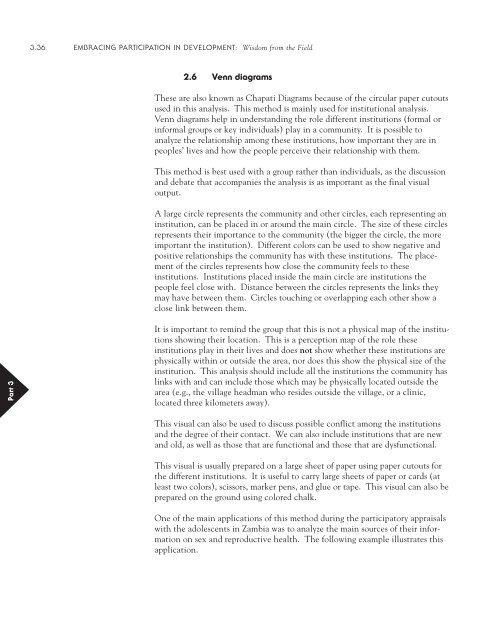PRA-Manual Embracing Participitation tools-only.pdf - PACA
PRA-Manual Embracing Participitation tools-only.pdf - PACA
PRA-Manual Embracing Participitation tools-only.pdf - PACA
You also want an ePaper? Increase the reach of your titles
YUMPU automatically turns print PDFs into web optimized ePapers that Google loves.
3.36 EMBRACING PARTICIPATION IN DEVELOPMENT: Wisdom from the Field<br />
2.6 Venn diagrams<br />
These are also known as Chapati Diagrams because of the circular paper cutouts<br />
used in this analysis. This method is mainly used for institutional analysis.<br />
Venn diagrams help in understanding the role different institutions (formal or<br />
informal groups or key individuals) play in a community. It is possible to<br />
analyze the relationship among these institutions, how important they are in<br />
peoples’ lives and how the people perceive their relationship with them.<br />
This method is best used with a group rather than individuals, as the discussion<br />
and debate that accompanies the analysis is as important as the final visual<br />
output.<br />
A large circle represents the community and other circles, each representing an<br />
institution, can be placed in or around the main circle. The size of these circles<br />
represents their importance to the community (the bigger the circle, the more<br />
important the institution). Different colors can be used to show negative and<br />
positive relationships the community has with these institutions. The placement<br />
of the circles represents how close the community feels to these<br />
institutions. Institutions placed inside the main circle are institutions the<br />
people feel close with. Distance between the circles represents the links they<br />
may have between them. Circles touching or overlapping each other show a<br />
close link between them.<br />
Part 3<br />
It is important to remind the group that this is not a physical map of the institutions<br />
showing their location. This is a perception map of the role these<br />
institutions play in their lives and does not show whether these institutions are<br />
physically within or outside the area, nor does this show the physical size of the<br />
institution. This analysis should include all the institutions the community has<br />
links with and can include those which may be physically located outside the<br />
area (e.g., the village headman who resides outside the village, or a clinic,<br />
located three kilometers away).<br />
This visual can also be used to discuss possible conflict among the institutions<br />
and the degree of their contact. We can also include institutions that are new<br />
and old, as well as those that are functional and those that are dysfunctional.<br />
This visual is usually prepared on a large sheet of paper using paper cutouts for<br />
the different institutions. It is useful to carry large sheets of paper or cards (at<br />
least two colors), scissors, marker pens, and glue or tape. This visual can also be<br />
prepared on the ground using colored chalk.<br />
One of the main applications of this method during the participatory appraisals<br />
with the adolescents in Zambia was to analyze the main sources of their information<br />
on sex and reproductive health. The following example illustrates this<br />
application.














